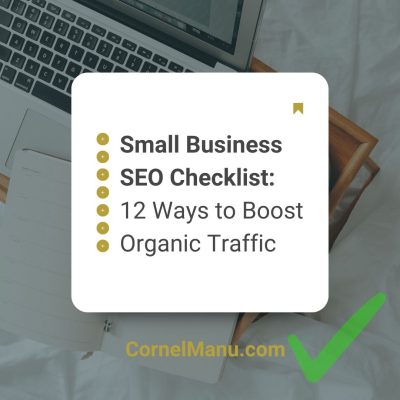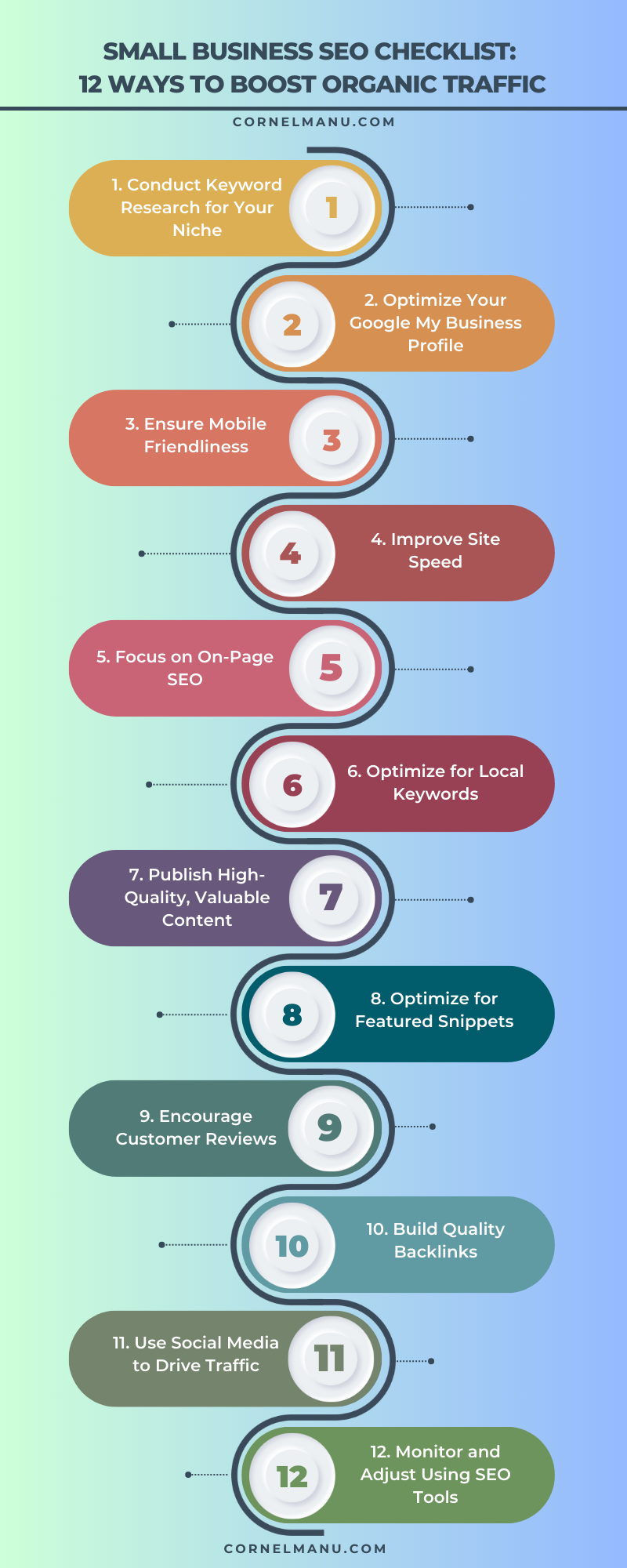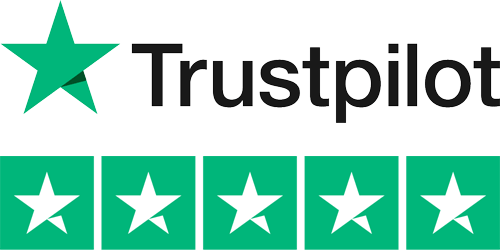Increase your online visibility to boost your sales by up to 30%+ per year. 📈
Get to the top spot in Google without breaking the bank!
Small Business SEO Checklist: 12 Ways to Boost Organic Traffic
 For small businesses looking to stand out online, organic traffic is essential. SEO (Search Engine Optimization) can be the key to attracting more customers, building brand awareness, and increasing revenue without a huge advertising budget.
For small businesses looking to stand out online, organic traffic is essential. SEO (Search Engine Optimization) can be the key to attracting more customers, building brand awareness, and increasing revenue without a huge advertising budget.
This checklist covers 12 essential SEO steps for small businesses to help you improve your search rankings, attract relevant traffic, and ultimately grow your business. Let’s dive into the details of how each tactic can support your SEO success.
1. Conduct Keyword Research for Your Niche
Keyword research is foundational to SEO. By identifying the right keywords, you’re better positioned to attract users who are already searching for what you offer. Here’s how to make the most of it:
- Use Free or Affordable Tools: Google Keyword Planner, Ubersuggest, and Answer the Public are excellent tools for discovering keyword ideas relevant to your niche. You can also try premium tools like Ahrefs or SEMrush if your budget allows.
- Focus on Long-Tail Keywords: Long-tail keywords are longer, more specific phrases like “eco-friendly coffee shops in Portland.” These keywords tend to have less competition and are easier to rank for, particularly for small businesses.
- Research Competitor Keywords: Identify keywords your competitors are ranking for, especially those with moderate to low difficulty. Targeting similar terms can help you attract their audience while establishing yourself in your niche.
By targeting low-competition keywords, you increase your chances of ranking quickly and generating quality traffic.
2. Optimize Your Google My Business Profile
Local SEO is essential for small businesses. Google My Business (GMB) helps you establish a presence in local search results and on Google Maps, connecting you with nearby customers.
- Complete Your Profile: Add accurate information about your business, including your address, hours, contact info, and a short description. Include images of your location, products, or services to make your profile more appealing.
- Encourage Reviews: Positive reviews can greatly influence your GMB ranking. Encourage satisfied customers to leave reviews, and always respond to them, showing that you value feedback.
- Regular Updates: Post updates about events, promotions, or new products directly to your GMB profile. These updates appear in local search results and signal to Google that your business is active.
An optimized GMB profile increases visibility for local searches and attracts more in-person and online traffic.
3. Ensure Mobile Friendliness
With over half of all searches now conducted on mobile devices, having a mobile-friendly website is non-negotiable. Google’s mobile-first indexing also means that a mobile-friendly site is crucial for search rankings.
- Use Google’s Mobile-Friendly Test: This free tool analyzes how mobile-friendly your site is and offers tips for improvement.
- Responsive Design: Ensure your website automatically adjusts to fit different screen sizes, from desktops to smartphones.
- Optimize for Touch: Make sure buttons, forms, and links are large enough to be easily tapped on mobile devices.
Prioritizing mobile usability provides a better experience for visitors and increases the likelihood of higher rankings in mobile search results.
4. Improve Site Speed
Page speed is a critical factor in user experience and SEO. A slow-loading website can frustrate visitors, causing them to leave, which increases bounce rate and hurts SEO performance.
- Use PageSpeed Insights: Google’s PageSpeed Insights tool assesses your site’s speed and gives actionable recommendations, such as reducing image sizes and minimizing JavaScript.
- Optimize Images: Compress images to reduce file size without sacrificing quality. Use formats like JPEG for photos and PNG for graphics.
- Leverage Browser Caching: Caching saves elements of your website for returning users, which can dramatically improve loading times.
Improving site speed can make your website more engaging and reduce bounce rates, which signals to Google that users are satisfied with your content.
5. Focus on On-Page SEO
On-page SEO involves optimizing individual pages on your site to improve rankings and drive relevant traffic. This includes title tags, meta descriptions, headers, and URL structure.
- Optimize Title Tags and Meta Descriptions: Craft unique, keyword-rich title tags (under 60 characters) and meta descriptions (under 160 characters) for each page. These elements are essential for on-page SEO as they tell search engines and users what each page is about.
- Use Header Tags (H1, H2, H3): Properly structured headers improve readability and help search engines understand the hierarchy of content on a page. Place primary keywords in your H1 tag and sub-keywords in H2s and H3s.
- Create SEO-Friendly URLs: Use clean, descriptive URLs that include keywords. Avoid long strings of random characters, and use hyphens to separate words.
Tools like Yoast SEO or Rank Math can simplify on-page optimization, ensuring your pages are optimized and ready to rank.
6. Optimize for Local Keywords
Local keywords are search terms that include a geographic location, helping you target users near your business. These terms are essential for small businesses that depend on a local customer base.
- Include Location-Based Keywords: Incorporate phrases like “pizza delivery in Seattle” or “Portland dental clinic” in key areas such as titles, meta descriptions, and content.
- Optimize Content with Local Terms: Reference neighborhoods, city landmarks, or community events relevant to your business. This enhances local relevancy and attracts users looking for nearby solutions.
- Add Schema Markup: Schema is a type of code that helps search engines understand your content better. Adding LocalBusiness schema markup provides more details about your location, helping search engines surface your content in local searches.
Local keywords improve your visibility in local searches, making it easier for customers nearby to find your business.
7. Publish High-Quality, Valuable Content
Content is key to attracting and retaining an audience. High-quality content not only helps with rankings but also builds trust and authority with your readers.
- Address Common Questions and Pain Points: Create content that provides solutions to issues your audience frequently encounters. Consider blog posts, FAQs, and guides that are relevant to your business.
- Use Keywords Naturally: Integrate keywords without overstuffing. Instead, aim for a natural flow that provides value to readers.
- Refresh Old Content: Regularly update older posts to keep them relevant and maintain their SEO value. Add new information, update statistics, and ensure all links are functional.
Consistently publishing valuable content improves SEO and helps establish your business as an authority in your industry.
8. Optimize for Featured Snippets
Featured snippets are information boxes that appear at the top of search results, providing concise answers to queries. Ranking for these snippets can significantly boost your visibility.
- Target Question-Based Keywords: Many snippets are triggered by questions, such as “How to tie a tie” or “What are the best SEO tips.” Answer these questions directly in your content to increase your chances of appearing in a snippet.
- Use Simple Formatting: Google often pulls content from lists, tables, and short paragraphs. Structure your content with these formats to increase snippet potential.
- Provide Clear Answers: Be concise and direct when answering questions within your content. Aim to address the question early in the text for better visibility.
Optimizing for featured snippets helps you capture a prominent position in search results, driving more traffic to your site.
9. Encourage Customer Reviews
Reviews can influence local SEO rankings and provide social proof, making your business more attractive to potential customers.
- Encourage Positive Reviews: Politely ask satisfied customers to leave reviews on Google, Yelp, and other platforms.
- Respond to All Reviews: Engage with customers by responding to their feedback. Thank positive reviewers and address any negative feedback professionally.
- Showcase Testimonials on Your Site: Display reviews and testimonials on your website. This can enhance trust and also provides fresh, user-generated content for search engines.
Reviews improve credibility, build trust, and contribute to higher rankings, particularly in local search results.
10. Build Quality Backlinks
Backlinks from reputable websites indicate authority and trustworthiness, which can improve your search rankings.
- List in Local Directories: Many local directories allow businesses to list for free. These directories often carry authority and can drive local traffic.
- Collaborate with Other Businesses: Partnering with local or complementary businesses for guest blogging or shout-outs can generate valuable backlinks.
- Write High-Quality Guest Posts: Reach out to relevant blogs in your niche and offer to write articles in exchange for a backlink. Focus on reputable sites to ensure quality over quantity.
High-quality backlinks from authoritative sites help establish your site’s credibility and improve SEO.
11. Use Social Media to Drive Traffic
Social media can indirectly boost SEO by increasing site traffic, brand visibility, and engagement.
- Share Blog Content: Promote blog posts and other website content on your social platforms to drive more visitors to your site.
- Engage with Your Audience: Respond to comments, share relevant news, and participate in discussions. Engagement strengthens brand presence and increases the likelihood of social shares.
- Optimize Profiles for SEO: Use consistent brand messaging and keywords in your social media profiles to make it easier for users to find you.
Social media engagement helps attract more visitors and can indirectly lead to improved SEO performance.
12. Monitor and Adjust Using SEO Tools
Regularly tracking your performance helps you stay on top of your SEO efforts and make data-driven decisions.
- Use Google Analytics and Search Console: Track metrics like organic traffic, bounce rate, and top-performing pages. Identify what’s working and areas that need improvement.
- Set Up Regular Check-Ins: Analyze performance data monthly to evaluate which strategies are driving results and where adjustments are needed.
- Track Keyword Rankings: Tools like Ahrefs or SEMrush can help monitor how well your keywords are ranking over time.
Monitoring your SEO metrics lets you make informed decisions to continuously improve performance and adapt to changes in search algorithms.
Conclusion: Implementing Your Small Business SEO Checklist
Following this checklist empowers small businesses to boost organic traffic, increase brand visibility, and grow sustainably. By implementing these strategies, you’ll set a strong foundation for long-term SEO success.
If you’re looking for expert assistance, my SEO services are designed to support small businesses with tailored strategies. My affordable SEO packages start at €500 per month, offering you customized SEO solutions to meet your unique needs. Reach out today to explore how professional SEO support can make a lasting impact on your business’s online presence.
Infographic

Share this:
- Click to share on X (Opens in new window) X
- Click to share on Facebook (Opens in new window) Facebook
- Click to share on LinkedIn (Opens in new window) LinkedIn
- Click to share on Reddit (Opens in new window) Reddit
- Click to share on Tumblr (Opens in new window) Tumblr
- Click to share on Pinterest (Opens in new window) Pinterest


Leave a Comment